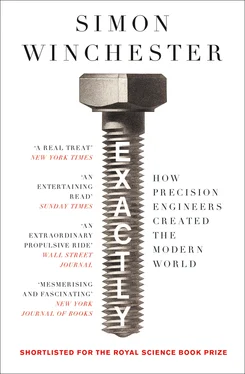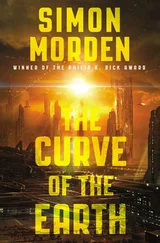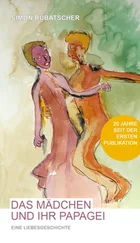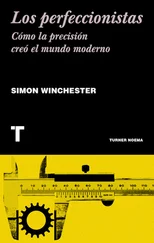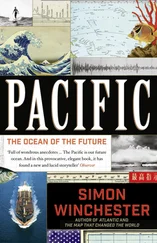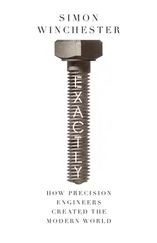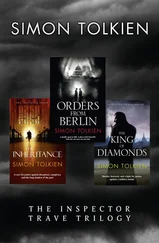It would not be until 1851 that the Bramah lock was successfully—although, as we shall see in a later chapter, controversially—picked and the very handsome pledge *redeemed. And in the years leading up to this event (which only their descendants would survive to witness), these two men, Bramah and Maudslay, proved themselves to be engineers supreme. They invented all manner of intriguing new devices, and they effectively and independently wrote the rule books for the precise world that was beginning to emerge as a consequence of (or, at least, in the wake of) John Wilkinson’s achievements with his cylinder-boring machine at Bersham. Some of the two men’s inventions have faded away into history; some others, however, have survived as the foundations on which much of today’s most sophisticated engineering achievements would eventually be built.
Though Maudslay remains today the better-known figure, with a legacy recognized by most engineers, Bramah was at the time perhaps the more showily ingenious of the pair. His first invention was dreamed up while he lay in bed after a fall, and must rank as the least romantic: for a London population that sorely needed an improvement in public hygiene, he built water closets, and he patented his ideas for a system of flaps and a float and valves and pipes that made the device both self-cleansing (flushing, indeed, for the first time) and free from the usual risk of freezing in winter that created unpleasant results for all. He made a small fortune from this creation, selling six thousand in the first twenty years of production, and a Bramah WC was still the centerpiece of the civilized English middle-class bathroom right up until Victoria’s Jubilee, a hundred years later.
Bramah’s interest in locks, which required far more intricacy and precise workmanship than a toilet, of course, seems to have started when he was elected in 1783 a member of the newly formed (and still there, in its original home) Royal Society for the Encouragement of Arts, Manufactures and Commerce. *What is now simply the Royal Society of Arts, the RSA, back in the eighteenth century had six divisions: Agriculture, Chemistry, Colonies and Trade, Manufactures, Mechanicks (spelled thus), and most quaintly, the Polite Arts. Bramah not unnaturally opted to attend most of the Mechanicks meetings and, soon after joining, rocketed to prominence by the simple act of picking a lock. Not so simply, actually: in September 1783, a Mr. Marshall had submitted for consideration what he declared was a formidably unpickable lock, and had a local expert named Truelove worry away at it with a quiverful of special tools for an hour and a half, before accepting defeat. Then, from the back of the audience stepped Joseph Bramah, who quickly fashioned a pair of instruments and opened the lock in fifteen minutes flat. A buzz of excitement went around the room: they were clearly in the presence of a most Mechanickal man.
Locks were a British obsession at the time. The social and legislative changes that were sweeping the country in the late eighteenth century were having the undesirable effect of dividing society quite brutally: while the landed aristocracy had for centuries protected itself in grand houses behind walls and parks and ha-has, and with resident staff to keep mischief at bay, the enriched beneficiaries of the new business climate were much more accessible to the persistent poor. They and their possessions were generally both visible and, especially in the fast-growing cities, nearby; they tended to live in houses and on streets within earshot and slingshot of the vast armies of the impoverished. Envy was abroad. Robbery was frequent. Fear was in the air. Doors and windows needed to be bolted. Locks had to be made, and made well. A lock such as Mr. Marshall’s, pickable in fifteen minutes by a skilled man, and by a desperate and hungry man maybe in ten, was clearly not good enough. Joseph Bramah decided he would design and make a better one.
He did so in 1784, less than a year after picking the Marshall lock. His patent made it almost impossible for a burglar with a wax-covered key blank, the tool most favored by the criminals who could use it to work out the position of the various levers and tumblers inside a lock, to divine what was beyond the keyhole, inside the workings. Bramah’s design, which he patented that August, had the various levers inside a lock rise or fall to different positions when the key was inserted and turned to release the bolt, but then had those same levers return to their initial positions once the bolt had been shot. The effect of this was to make the device almost burglar-proof, for no amount of foraging with a wax key blank would ever allow a picklock to work out where the levers needed to be (as they weren’t there anymore) in order to free the bolt.
Once Bramah had come up with this basic mechanical premise, it remained for him, with great cleverness and elegance, to form the entire lock into a cylindrical shape, with its levers not so much rising and falling under the influence of gravity as moving in and out along the radii of the cylinder under the impress of the key’s various teeth, and then moving back to their original positions with the aid of a spring, one for each lever. The entire lock could thus be rendered as a small tube-shaped brass barrel, which could be easily fitted into a tube-shaped cavity in a wooden door or an iron safe, and with the deadbolt flush to the door’s outer edge (when the lock was open) or settled into its brass cavity in the door frame (when securely closed).
Joseph Bramah would go on to invent many more contraptions and concepts during his life, many of them having nothing to do with locks, but involving his particular other fascination with the behavior of liquids when subjected to pressure. He invented the hydraulic press, for example, with its vast importance in industry worldwide. More trivially, he launched onto the market a primitive form of fountain pen *and drew designs for a propelling pencil; more lastingly, he made the beer engine, which is still employed by the more traditionally minded innkeepers, and which would allow beer kept cool in a cellar to be pressure-delivered to thirsty customers in the bar above. (This invention obviated the need for the bartender to stagger up and down the cellar stairs, lugging fresh barrels of ale.) Draft beer drinkers today have little cause to remember the name “Bramah,” though there is a pub in Lancashire named for him. Likewise, few banknote printers know that it was Joseph Bramah who made the first machine that could cleverly ensure that their thousands of identical bills each bore a different sequential number. He also made an engine for planing large wooden planks, another for making paper, and he forecast that, one day, large screws would be used to propel big ships through the water.
Yet it is really only by way of his lock making that Bramah’s name has now formally entered the English language. True, one can still find in literature references to a Bramah pen and a Bramah lock—the Duke of Wellington wrote admiringly of each, as did Walter Scott and Bernard Shaw. Yet when the word is used alone—and Dickens did on numberless occasions, in The Pickwick Papers , in Sketches by Boz , in The Uncommercial Traveller —it is a reminder that at least for the Victorian citizenry, his was an eponym: one used a Bramah to open a Bramah, one’s home was secured with a Bramah, one gave a Bramah to a favored friend so he or she might visit at all hours, come what may. Only when Mr. Chubb and Mr. Yale arrived on the scene (noted by the Oxford English Dictionary as first making it into the language in 1833 and 1869, respectively) did Joseph Bramah’s lexical monopoly hit the buffers.
What made a Bramah lock so good was its vastly complicated internal design, of course, but what made it so lastingly good was the precision of its manufacture. And that was less the work of its inventor than of the man—the boy, really—whom Bramah hired to make copious numbers of his device and to make them well, to make them fast, and to make them economically. Henry Maudslay was eighteen years old when Bramah lured him away as an apprentice: he would go on to become one of the most influential figures in the early days of precision engineering, his influence being felt to this day both in his native Britain and around the world.
Читать дальше
